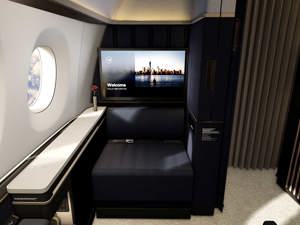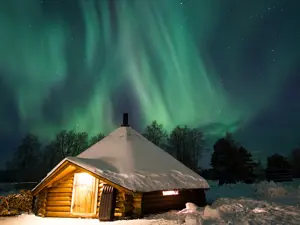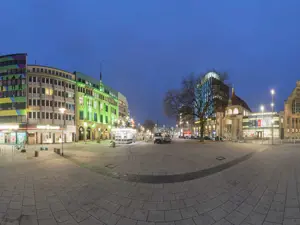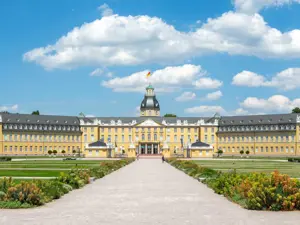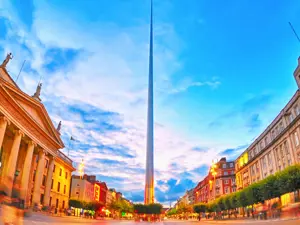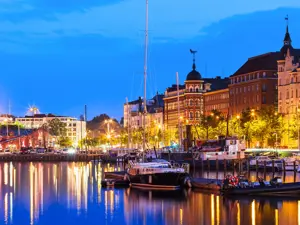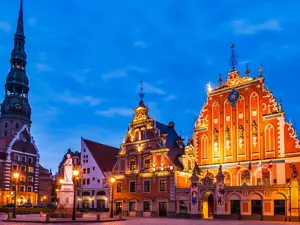A city that welcomes visitors with its magical atmosphere
One of the most beautiful cities in Germany, found in the large open spaces, courses of the purest water, sophisticated shopping centres and night spots and bars. Nothing is missing from Hamburg: it’s the second largest city in Germany with one million eight hundred inhabitants, and is characterised by marked contrasts, with the poorest districts cohabiting with those of extreme luxury.

Hamburg. Panoramic view of the Lake Binnenalster. Copyright © Sisterscom.com / Shutterstock
The most intriguing and colourful district is without doubt St. Pauli, the most impoverished of the city, which is crossed by the Reeperbahn, also known as the red-light district. Instead, the picturesque, elegant area of Blankenese is rich and ordered with prestigious villas that overlook the water and white beaches of the River Elbe: due to its position and layout it is known as the Positano of the North.
The maritime charm of Hamburg
Is manifested in its 2496 bridges which connect the numerous canals known as Fleet, giving the city the name of Venice of the North. Another river, the Alster, forms striking artificial lakes connected to canals. Situated on the Elbe estuary, the city also boasts an extraordinary port at which some 13,000 ships from all over the world arrive, including large cruise ships. It’s no coincidence that since ancient times Hamburg has earned the title of ‘world’s port’. A city of water, therefore, which is worth visiting on one of the efficient and punctual steamboats to discover its wonders.

Hamburg. Copyright © Sisterscom.com / Shutterstock
The Church of St. Michaelis in Hamburg
The symbolic building of Hamburg is the Church of St. Michaelis, known affectionately by the residents as Michel, the most significant Baroque construction in Germany, which is dedicated to the Archangel Gabriel. Its tower, at a height of 132 metres, is one of the highest in the world, and from its panoramic platform a spectacular view of the city can be enjoyed over the historic buildings, canals, green parks and the inner Lake Binnenalster, a true haven for enthusiasts of sailing, canoeing or rowing.

Hamburg. Church of St. Michaelis. Copyright © Sisterscom.com / Shutterstock
One of the striking historic buildings is the imposing City Hall, which was rebuilt and inaugurated in 1897 after it was devastated by a fire in the mid nineteenth century. The facade is lavishly decorated with the statues of twenty emperors beginning with Charlemagne. The main entrance is engraved with a motto in Latin ‘they wish to worthily preserve for posterity the freedom that their ancestors were able to conquer’.

Hamburg. City Hall. Copyright © Sisterscom.com / Shutterstock
Since the era of the Hanseatic League, Hamburg has been a free city open to new ideas coming in from all over the world. As a reminder of its fortunate and industrious trading past, alongside the City Hall is the historic Hamburg Stock Exchange building, the oldest of its kind in Germany. Another seventeenth-century building that takes one back to the trading times of old Hamburg is the Krameramtswohnungen, an ancient guild that provided merchants with a house; inside, one of these houses, still in its original condition, is open to the public.
The Fishmarket of Hamburg
Particularly interesting is the Fish market, the most traditional and colourful market of Hamburg, founded in 1703, where on Sunday from 5 a.m. to 9.30 a.m. goods of all kinds, from antiques to food, are displayed. Tourists are fascinated by the atmosphere of this market, where in the historic fish auction hall, brunch is served to the sound of jazz or country and western music.

Hamburg. Port. Copyright © Sisterscom.com / Shutterstock
Large green spaces in Hamburg
Hamburg is a lively, cheerful city, with large parks perfect for relaxing or even practising a sport such as jogging. Also worthy of a visit is the Hagenbeck Zoological Garden, where animals of every species live in natural conditions, but the most important attraction is the very large, interactive aquarium, and the Planten un Blumen, in the city centre, with the largest Japanese Garden in Europe, where in the evening, from May to September, fascinating water features and first-class music concerts can be enjoyed.

Hamburg. Japanese garden. Copyright © Sisterscom.com / Shutterstock
The dishes of Hamburg
Hamburg is definitely the city of Germany where you can taste fish and seafood. One of the specialties not to be missed are the Fischbrötchen fish sandwiches. Stuffed with herring or salmon with addition of cucumber, onion, and pickles. The best sandwiches of the city can be tasted between 5 and 6 in the morning, when the fishing boats head in the harbor with the catch of the night, at the Fischmarkt (fish market). The typical dessert is the Franzbrötchen, a kind of puff pastry baked in the oven with butter, cinnamon, chocolate or raisins.
Text by Anna Glik
Updated by Alisè Vitri
Avion Tourism Magazine
Photos for editorial use only: Sisterscom.com, Shutterstock
Copyright © Sisterscom.com
Tourism Board
www.hamburg.de
www.germany.travel
Partnership with Booking.com
Where to sleep in Hamburg
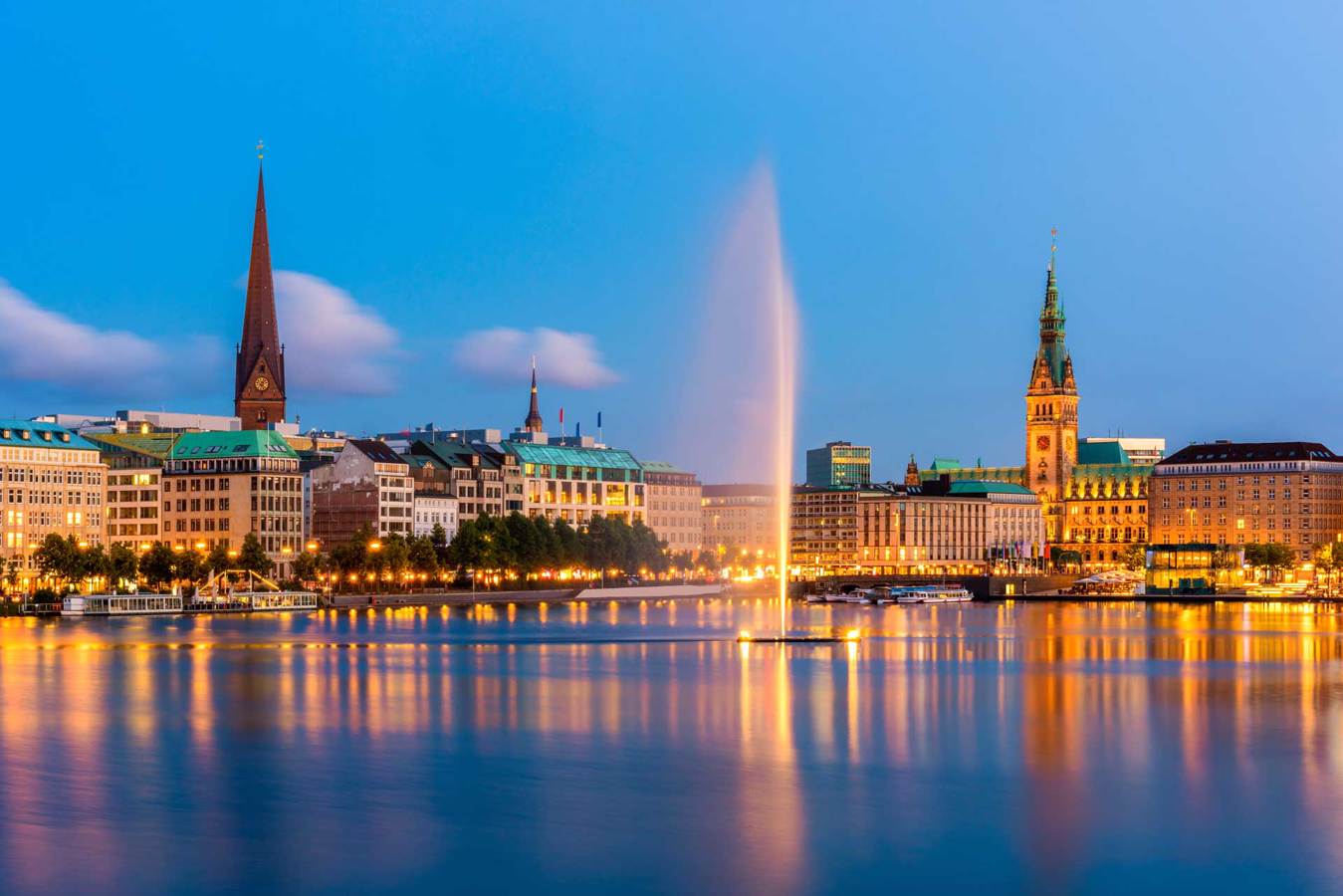
Hamburg. Copyright © Sisterscom.com / Shutterstock
Hamburg is a welcoming city and offers different possibilities for accommodation.
To find the ideal hotel and the best offers you can do a search for the stars but also for districts or landmarks.
DISTRICTS
Hotels in the districts
LANDMARKS
Hotels in tourist areas
AIRPORT
Hotels near the airport
Where to go in Hamburg
Monuments of Hamburg

Copyright © Sisterscom.com / Shutterstock
ST. MICHAELS’ CHURCH
The St. Michael's Church in Hamburg is a city landmark and the most important Baroque church in northern Germany. It is also one of the largest “beacons” in the world because, for many years, it served as a landfall mark for ships sailing up the River Elbe. The belfry is 132 metres tall and has almost 450 steps. The viewing platform at the top of the tower affords a wonderful view of Hamburg and the port. The nave is 52 metres long and has an impressive 20 metre altar and the largest belfry clock in Germany, with hands that weigh 130 kg.

Copyright © Sisterscom.com / Shutterstock
CITY HALL
Built in neo-Renaissance style between the years 1886-1897, the City Hall of Hamburg is found in the centre of the city, between the rivers Alster and Elbe, and has 650 rooms. This stunning granite and limestone building has 3 wings, a facade 112 metres long and rich in decorations, a 112-metre tower and a roof covered in copper. The recesses at the side of the city hall, which overlook the adjacent square, contain bronze sculptures of 20 kings and emperors of the German empire, from Charlemagne to Francis II.

Copyright © Sisterscom.com / foto-select / Shutterstock
DOCKLAND BUILDINGS
This complex of six-floor buildings on the banks of the Elbe is one of the most spectacular constructions in Hamburg. It takes the shape of a parallelogram and protrudes 40 metres over the river. Stairs lead to the viewing platform on the six floor from where there is a breathtaking view over the river and city. Inclined transparent lifts lead to the individual floors.
Museums in Hamburg

Copyright © Sisterscom.com / Claudio Divizia / Shutterstock
KUNSTHALLE
This museum exhibits over 700 works of art from the Middle Ages to the present day, seventeenth-century Dutch paintings and nineteenth-century German paintings with works by Caspar David Friedrich, Philipp Otto Runge, Adolph Menzel and Max Liebermann, and works from the Classical Modernist period by Wilhelm Lehmbruck, Edvard Munch, Emil Nolde, Paul Klee, Ernst Ludwig Kirchner, Max Beckmann, Lyonel Feininger, George Grosz and Max Ernst.

Copyright © Sisterscom.com / foto-select / Shutterstock
BUCERIUS KUNST FORUM
Situated near the City Hall, the Bucerius Kunst Forum organises important exhibitions each year. The core collections include classical modern works by Picasso, Kokoschka and Frida Kahlo, but it often organises exhibitions that cross different eras. The programme also includes concerts, conferences and lectures.

Copyright © Sisterscom.com / Igor Marx / Shutterstock
DEICHTORHALLEN
EXHIBITION CENTRE
The rooms is this centre are among the largest contemporary art and photography halls in Europe and are divided into the photography house, the contemporary art hall and the Falckenberg collection in the Harburg branch. These historic buildings, situated between the centre and the district of HafenCity, offer space for spectacular exhibitions, including international events dedicated to nineteenth and twentieth-century photography as well as digital photography of the future.
Tour in partnership with GetYourGuide
Excursions in Hamburg

Copyright © Sisterscom.com / Shutterstock
RIVER ALSTER AND THE BINNENALSTER AND
AUßENALSTER LAKES
In the centre of Hamburg, the River Alster widens to form two lakes, the Binnenalster and the Außenalster. Lake Außenalster is an ideal place for running or walking along the paths that follow its shores, while with sails or oars the waters can be crossed in all directions. The park and other surrounding green areas with trees offer places for enjoying the lakes in complete relaxation.

Copyright © Sisterscom.com / aldorado / Shutterstock
JUNGFERNSTIEG
Jungferstieg, an urban promenade, extends along the southern bank of Lake Binnenalster to Gänsemarkt square. It features some fine buildings, some of the best hotels in the city, banks and the entrance to Europa Passage, one of the most elegant shopping centres of the city.

Copyright © Sisterscom.com / Shutterstock
SPEICHERSTADT COMPLEX
The Speicherstadt, a warehouse complex, is located between the Deichtorhallen Museum and the Baumwall fortifications in the free port. It is a wonderful space in an international port built in eighteenth-century Gothic-style architecture, with pediments, towers and alleyways. It stores coffee, tea, spices, tobacco and now computers and oriental rugs and is one of the most popular attractions of the port.

Copyright © Sisterscom.com / Shutterstock
HAFENCITY
This is a new city district and offers a model of development for water cities. It is located directly on the port and gives the city a modern appeal. This lively urban space covers an area of 157 hectares and combines offices and residential areas, commercial activities, leisure activities, food and wine and culture.

Copyright © Sisterscom.com / Shutterstock
PLANTEN UN BLOMEN PARK
This park offers much more than just trees and flowers: flora, fauna, manicured lawns, a tropical greenhouse, botanical garden, streams and ponds. It is also possible to visit a Japanese tea house, walk in the rose garden, skate, ride a pony (for children only), play minigolf, go on the trampolines (open also to adults), stop in one of the open-air bars or watch a light show over the water.

Copyright © Sisterscom.com / vvoe / Shutterstock
ST. PAULI DISTRICT
This is an ideal district for fun evenings as it offers numerous restaurants, pubs, bars, night clubs and coffee bars. The area is home to the well-known Schmidt and Schmidt's Tivoli theatres, the Keese coffee bar and the Quatsch Comedy Club.
Recommended tours in Hamburg

Copyright © Sisterscom.com / Shutterstock
Hamburg's most recent attraction is the Elbphilharmonie, with the incredible building in the HafenCity district. Interesting tours allow you to discover all its beauties. Discover with the tours: Tour of Elbphilharmonie or HafenCity food tour and Elbphilharmonie visit.

Copyright © Sisterscom.com / Shutterstock
With Speicherstadt illuminated in the evening you can sail along the port of Hamburg to discover the HafenCity district, the Elbphilharmonie and the piers of St Pauli. Discover with the tours: Evening illumination cruise through Harbor or the Hamburg Harbor light tour.
Discover all tours
News & Useful info
You might be interested in
Destinations found in the vicinity
Other destinations
Airports nearby Hamburg








